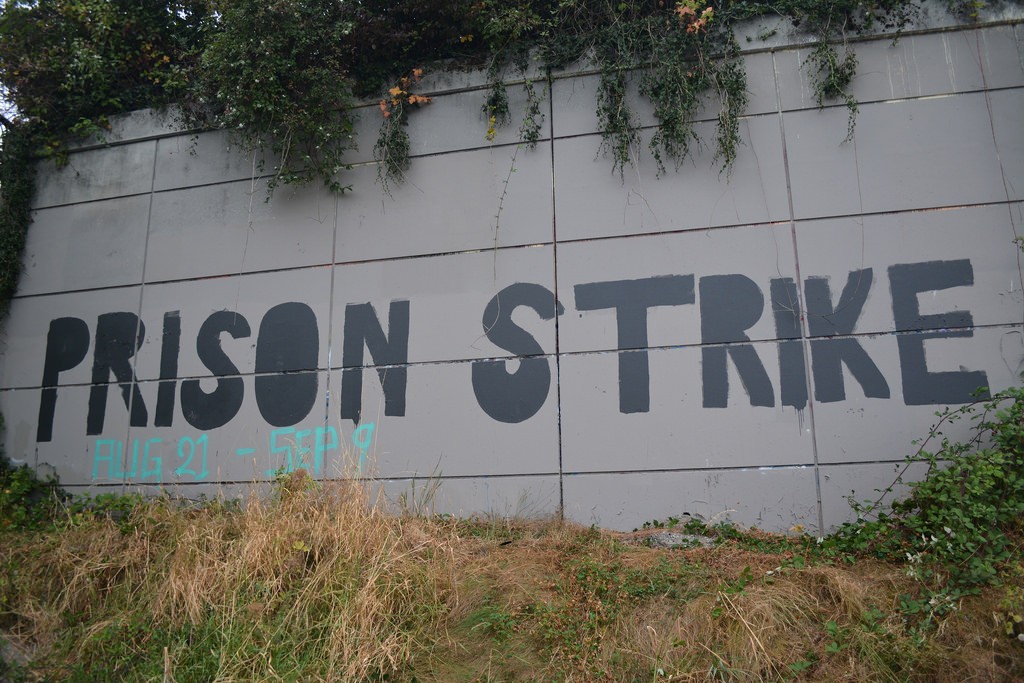Filed under: Action, Featured, Incarceration, US

The Prison Strike Media Team offers up a roundup and analysis of repression following the National Prison Strike and announces some next steps going forward.
The extent of repression and retaliation by prison authorities against suspected participants in this year’s nationwide prison strike continues to emerge slowly. The National Lawyers Guild Prisoners’ Legal Advocacy Network (NLG-PLAN) has received additional details from 12 states, including:
- widespread “staff-perpetrated physical abuse, destruction of prisoners’ personal property, theft/destruction of prisoners’ legal property, and obstruction of prisoners’ access .. e.g. .. to process grievance forms”
- scatter-shot retaliation against jailhouse lawyers, including “prevent[ing] them from jailhouse lawyering by placing them into solitary confinement under false pretenses”
- preemptive lock-down and segregation of thousands of prisoners, “in the absence in many cases of any apparent indication that the prisoners were involved in [the nationwide strike]”
- “remarkable nationwide consistency in .. correctional systems’ talking points as cited in the media” — prison officials in areas where intense repression was reported “have staunchly refused to acknowledge prison strike activities in their facilities”, following a plan distributed by the American Correctional Association after the 2016 strike.
In Halifax, Nova Scotia, testimony in a habeas corpus application has confirmed that 40 people held in a “close supervision unit” have been confined to their cells 23 hours a day, on one occasion for a continuous 36-hour period, for several weeks. This action comes after 10 members of prison staff refused to work in the unit, and commenced during the non-violent strike previously reported.
The Times-Union in Jacksonville, Florida reported that two letters from its journalists asking about the strike were rejected by officers at Okeechobee Correctional Institution on the grounds that they were a “threat to the security, order, or rehabilitative objectives of the correctional system, or the safety of any person”.
Meanwhile, severe restrictions have been imposed on correspondence and reading materials in Pennsylvania and Ohio following claims that contact with synthetic cannabinoids left dozens of prison staff sick. This theory has been broadly rejected by medical professionals; a past president of the American College of Medical Toxicology said “In a word, it’s implausible.. One thing we know about [synthetic cannabinoids] is that they don’t cause the effects these folks are having, and certainly not by the route that they’re being exposed … The symptoms are much more consistent with anxiety.” People in prison, their families and supporters fear that the changes, costing tens of millions of dollars, will effectively shut down groups like Books Through Bars in those states, as well as expose client-attorney communications to surveillance.
At Indiana State Prison, whistleblower Aaron McDonald is now under a one year non-contact visitation status in retaliation for exposing the inhumane conditions and rampant abuse going on inside. His mother, Leslie Hernandez is facing bogus charges for her outside organizing and support for her son. IDOC Watch is monitoring the situation and preparing the next move to defend them both.
The crackdown against incarcerated activists in Youngstown, Ohio has intensified. Imam Siddique Hasan, a prisoner leader on death row following the 1993 uprising in Lucasville Ohio received a one year phone restriction and security level hike, while multiple supporters were permanently banned from visiting any Ohio prisons. Officials at the supermax where Hasan is held have also engaged in collective punishment by increasing visitation restrictions, especially targeting organizer Greg Curry. Prosecutor Mark Peipmeier also filed motion to set an execution date for Hasan’s friend, Keith LaMar, who was also falsely convicted following the uprising. This motion came shortly after the strike, but LaMar was not involved in strike organizing.
In nearby Toledo, Ohio David Easley, James Ward, and Matt Hinkston engaged in another hunger strike September 14th to raise up the ten prison strike demands, in protest to their own isolation after the August 21st strike and to fight for proper mental health treatment for their fellow incarcerated comrades.
In order to most effectively capture the energy that has been generated during the National Prison Strike, Jailhouse Lawyers Speaks has established the Millions for Prisoners’ Human Rights Coalition. The coalition aims to include 400+ groups and organizations that endorsed the National Prison Strike as well as individuals who’ve signed on in solidarity with prisoners. The coalition is committed to the achievement of all of prisoners demands beyond the strike dates.
The Coalition will be led by incarcerated organizers who relay updates to coalition members on at least a bi-weekly basis. The strategy moving forward will include outside members supporting different forms of prisoner led resistance. At this time JLS is focused on informing policymakers about the National Prison Strike and has requested that the coalition collect signatures and send letters to members of Congress on the state and federal levels. To date the online petition has collected well over 30,000 signatures and has sent thousands of letters demanding that prisoners’ human rights be met. Coalition Sign up link: http://sawarimi.org/jls-prisoners-initiative
While reporters and supporters are eager to know, no plans have been solidified and no dates have been released for a National Prison Strike next year. In the coming months JLS will be leading resistance by relaying actions through the Millions for Prisoners’ Human Rights Coalition. Supporters as well as reporters are encouraged to join the coalition in order to stay informed about JLS’s next steps.
We look forward to seeing the outcomes of JLS strategy leading collective action from the inside in pursuit of each of the demands. As the months continue, actions progress and results materialize, JLS will be able to give more informed details about future events that best respond to the nation’s desperately volatile criminal justice climate.
Tags: #August21 #PrisonStrike




